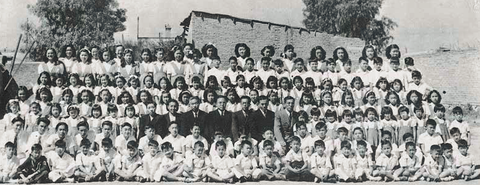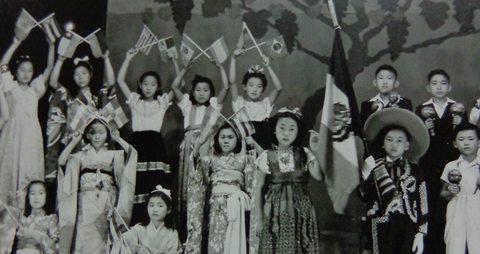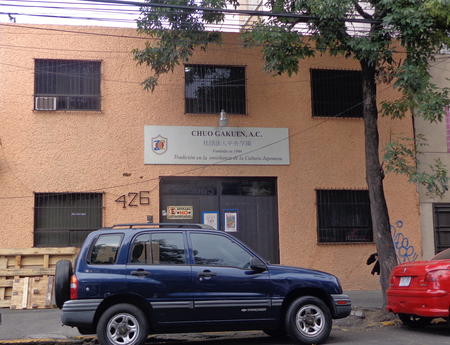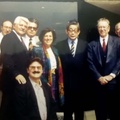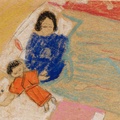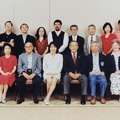For 72 years, the Chuo Gakuen school has provided Japanese language and cultural education to Nikkei and Mexican children. The school, located in a modest neighborhood in the center of Mexico City, is celebrating this anniversary thanks to the hard work and tenacity of many people who have made sure this educational project stays alive. Japanese pioneers, since the school’s establishment in 1944, always considered education to be their primary responsibility, in order to create a better future for their children born in Mexico.
The Chuo school was founded during the war, during the most difficult and complicated time that Japanese immigrants had experienced in Mexico and throughout the continent. Perhaps because of these circumstances, the school has been immune to all kinds of difficulties and has overcome numerous challenges. The year that it was founded, the Pacific War was still underway and Japanese communities dispersed in different regions of Mexico were forced to leave the towns where they had settled and move to Mexico City and Guadalajara, so they could be placed under close surveillance.
The Japanese immigrants and their children had to adapt to adverse conditions, including finding a place to live, new jobs and a new lifestyle in the city. The children of the first immigrants were already Mexican citizens by birth and in the mornings they attended Mexican schools. However, their parents wanted them to maintain ties with the culture of their ancestors, which they did mainly through teaching them Japanese. The Chuo school was founded through the cooperation and participation of immigrants who despite their financial problems, contributed a portion of their meager incomes to rent a facility and pay a teacher to provide classes in Japanese language and other subjects.
Why were they so determined to educate their children and work so hard for their education? When they arrived in 1897, the first immigrants, despite not being skilled workers, had at least attended elementary school. The workers and peasants who came from Japan to work in agriculture, mines and sugar mills in Mexico attended school in Japan, where an elementary education had been obligatory since the Meiji era (1868-1912). The Meiji educational effort was so successful that it situated Japan, from that time onward, among the countries with the highest literacy and schooling rates in the world.
In the midst of the forced concentration of Japanese immigrants in early 1942, the idea of creating schools for children became their top goal. They believed, despite not knowing when the war would end, that "children's development could not wait and teaching the Japanese language should be a priority.”1
The Chuo school began operating on the second floor of the Mutual Aid Committee (Kyoei-kai), an association that organized the support of concentrated families in Mexico City who had been forced to move from the provinces. Fortunately, the Mexican government allowed the organization to continue functioning, and also permitted the establishment of schools in the Tlalpan and Tacuba neighborhoods, and later in Contreras and Tacubaya. Although they were still under surveillance, the concentrated Japanese were allowed to meet and organize their five schools to teach children the Japanese language. This strengthened the communities living in different neighborhoods around the city and helped them succeed after the war ended. The negative effects of the concentration, therefore, were reverted and communities that had previously been isolated in small towns found a propitious environment in Mexico City to organize and educate their children.
In 1945, the Chuo school moved to its current location on 5 de Febrero Street, in a former button factory. Mr. Sanshiro Matsumoto and Dr. Takaichi Hojyo, who years before had become Mexican citizens, signed the contracts to lease the school building and took care of all the business arrangements, since the bank accounts and property of the Japanese community had been frozen because of the war. The former factory was not initially a suitable facility, so the parents and students participated in repairs, maintenance and cleaning to adapt it. All of the children have special memories of the rainy season, when they placed buckets to capture the water pouring off the roof and prevent their classrooms from flooding.
At that time the majority of the students attended classes in the afternoon, from 2 p.m. to 6 p.m. The school day for these children was arduous, as they attended public school in the morning and arrived home in the evening with homework from both schools. Mr. Hideo Yamashiro was the school's first director, as well as a teacher, during the first two years.
In 1954, the school became more academically rigorous with the addition of a trained teacher: Professor Kiyoshi Ebisawa. Thanks to his training and dedication to the children, Professor Ebisawa established a methodology and rigor in the teaching that elevated the academic level of the school. He also established arts, athletic and civic education programs. As a result of his recognition and prestige, in 1977 Professor Ebisawa was named director of the Liceo Mexicano Japonés (Japanese School of Mexico) when it was founded in 1977.
The creation of the Japanese School of Mexico--still one of the most prestigious schools in Mexico City--was a major achievement for the entire community of immigrants. It was the result of a widespread desire for and commitment to establishing a bi-cultural school that would serve not only the Japanese community but also Mexican students, and was a way of recognizing Mexico for having received the Japanese immigrants. The founding of the Japanese School of Mexico, however, represented an enormous challenge for many Chuo students who were unable to attend the Japanese School because of its location south of Mexico City. The Chuo school was without a leader after Professor Ebisawa left, but in addition, many of the parents who had actively participated in the functioning of the Chuo school moved their children to the Japanese School. Once again, it was through the hard work and determination of the parents and students who remained at the Chuo school that it was able to survive and enter a new phase of its existence.
In 1985, Professor Kayo Matsubara became involved in the school's leadership. She had earned a biology degree from the National University but had studied at Chuo as a girl. Her father, in fact, helped build the school, so she felt an immense responsibility to make sure the school did not disappear. Matsubara, as the Chuo school’s director, has been able to adapt it to the new circumstances. Now the school provides classes not only to Nikkei children, but to all children interested in learning about Japanese culture. Moreover, groups of students and adults who want to learn Japanese regularly attend classes offered at the Chuo school. It has become, therefore, the oldest educational institution in Mexico that promotes closer ties between the two cultures.
The recognition of Japanese culture in Mexico is due not only to the recovery and growth of the Japanese economy since the end of the 20th century, but also to the prestige and integrity of the many well-known professionals of Japanese origin in Mexican society. It is important to remember that many of the dentists, doctors, accountants, architects and professionals in many other fields graduated from the five small schools created by the Japanese community during the war years. The Chuo school, because of its persistence, serves as a model and guide to ensure that we never forget that education continues to be the most important path and tool for overcoming the difficulties we currently face.
Note:
1. Kagayaki (Radiance), a book commemorating the 50th anniversary of the Chuo Gakuen.
* * * * *
Our Editorial Committee selected this article as one of their favorite Nikkei-go stories. Here is the comment.
Comment from Javier García Wong-Kit
For Hernández Galindo, the Japanese language represents Nikkei identity. The story of Chuo Gakuen is unique because it became a significant icon for the Nikkei community in Mexico. The author’s research accentuates one of the main concerns of Japanese migrants: the importance of passing on to their children the language of their own education. Hernández Galindo’s deep investigation speaks to his commitment to studying the roots and culture of Japanese migration. His findings on their political and social context are a great contribution.
© 2016 Sergio Hernández Galindo


